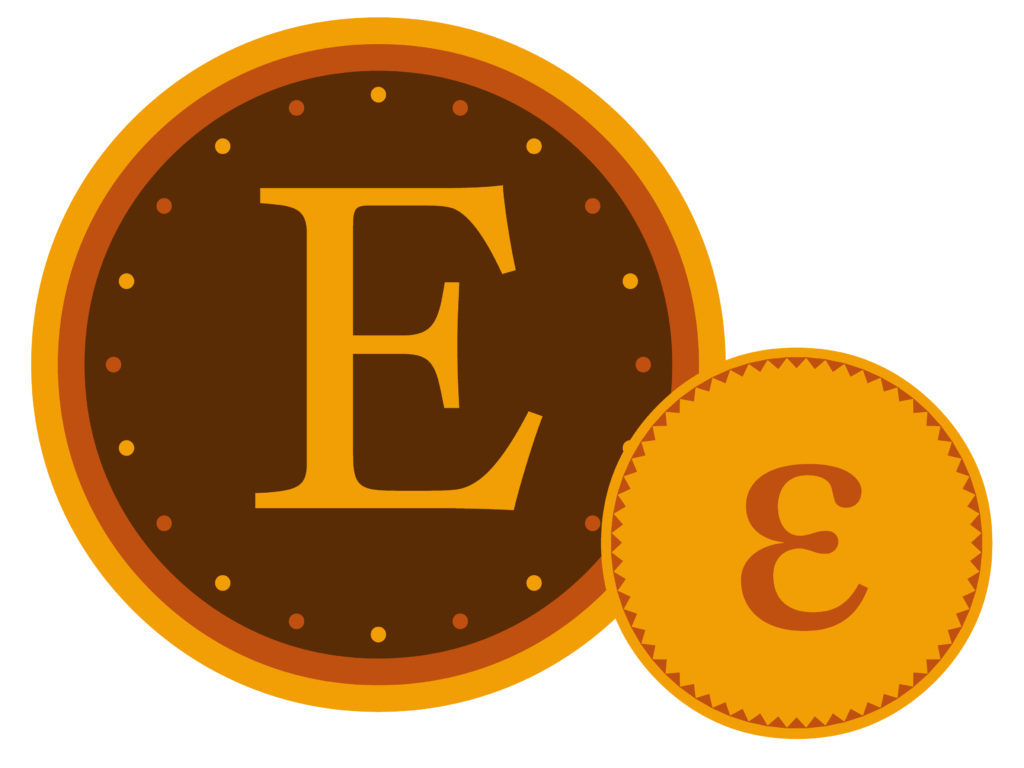Carrying on our in-depth overview of the Greek alphabet, we are examining another interesting ancient Greek symbol today: without further ado, here is everything you need to know about the epsilon symbol, its meaning, origin and uses in math and science.
Epsilon is the fifth letter in the Greek alphabetic system, which is preceded by delta and followed by zeta letters. The sign represents a variable, like the symbols x, n, and T. In math and science, it may be used to denote an arbitrarily small quantity, like an error, or a value that can be taken as zero in some limit.

The epsilon is denoted by two different symbols for its uppercase and lowercase forms. The uppercase form is the same as the Latin capital alphabet E.
However, what many people don’t know is that the epsilon has two lowercase variants derived from Medieval Greek handwriting.
- The most commonly used variant (ε) looks like a reversed 3
- The other symbol, known as the lunate or uncial epsilon, looks like an open semi-circle crossed by a horizontal line (ϵ).
While these symbols may simply be different font versions in regular typography, they have different meanings in mathematics.
Aside from these, there is also a Latin epsilon, also known as an “open e,” which looks very similar to the lowercase Greek epsilon sign. The Latin epsilon is used as an IPA symbol.
In the system of Greek numerals, the value of epsilon corresponds to five.
Table of Contents
The Origin Of The Epsilon Symbol
The name of the symbol was originally εἶ (pronounced like bay but without the glide). However, during the Middle Ages, it was changed to ἒ ψιλόν (e psilon) to differentiate the symbol from the digraph (αι) which was pronounced in the same way.
The epsilon symbol was derived from the Phoenician letter Hē () that represents “window.” It was taken during the times when the ancient Greeks started adopting alphabetic writing. In archaic Greek writing, the epsilon symbol is still depicted as the Phoenician letter.
During the Classical era, the epsilon symbol was simplified to our current-day “E” due to the influence of cursive writing styles.
The Euro symbol (€) was also inspired by the lunate epsilon.
Uses of the Epsilon Sign
Today, the uppercase epsilon, denoted by the Latin capital letter E, is not typically used except in Greek text or in structural mechanics with Young’s modulus equation (E=FL0/A ∆L)
However, the Greek lowercase epsilon symbol is used in astronomy, chemistry, mathematics, computer science, economics, and continuum mechanics.
In mathematics and statistics, the epsilon is used in a variety of functions and equations. Conventionally, the ε symbol represents an arbitrarily small but positive quantity (greater than zero). Relating to this, Paul Erdos, a renowned Hungarian mathematician, used the term “epsilons” to refer to children.
In linear algebra, the epsilon sign is also used to denote dual numbers
People who are familiar with computer science know that the epsilon symbol is used to represent the empty string or empty word, though some mathematicians use the lower-case Greek alphabet lambda (λ) as well.
In agricultural sciences, the epsilon is used to represent the efficiency of photosynthesis in a specific plant.
Economists use the epsilon sign to refer to elasticity, which is the proportionate change in one variable in response to a change in another variable.
Interestingly, Epsilon is also the name of Uranus’ brightest and outermost ring. The epsilon symbol also represents the fifth-brightest star in a constellation, as designated by the Bayer designation — not surprising, since epsilon is the fifth Greek letter and represents the value of 5.
Did you enjoy reading about the epsilon symbol, its meaning and origins? If you did, you will probably want to check out our massive symbols and meanings section in which we cover other Greek symbols along with countless symbols from other cultures! Please kindly browse it using the top menu. Thanks for reading on Mythologian!
